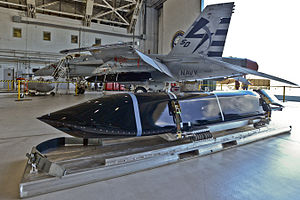| AGM-158C LRASM | |
|---|---|
 A Long Range Anti-Ship Missile (LRASM) mass simulator integrated on an F/A-18E Super Hornet | |
| Type | Anti-ship missile |
| Place of origin | United States |
| Service history | |
| In service | 2018–present |
| Used by | |
| Production history | |
| Designer | DARPA |
| Designed | 2009–2017 |
| Manufacturer | Lockheed Martin |
| Unit cost | USD $3.24 million (FY24)[1] |
| Produced | 2017–present |
| Specifications | |
| Mass | 2,760 lb (1,250 kg) (est) |
| Length | 14 ft (4.26 m) (est) |
| Width | 25 in (635 mm) (est) |
| Height | 18 in (450 mm) (est) |
| Wingspan | 8 ft 10 in (2.7 m) |
| Warhead | WDU-42/B HE blast fragmentation penetrator |
| Warhead weight | 1,000 lb (453.6 kg) |
Detonation mechanism | FMU-156/B fuze |
| Engine | Williams F107-WR-105 turbofan |
Operational range | 200 nmi (370 km)[2] |
Guidance system | GPS, INS, IIR (EO), with AI guidance in on-board sensors (to detect high-value target) |
Steering system | Moving wings, 2 horizontal tailplanes & 1 vertical stabilizer |
| Accuracy | 9 ft 10 in (3 m) CEP |
Launch platform |
|
| References | Janes[3][4][5] & AFA[6] |
The AGM-158C LRASM (Long Range Anti-Ship Missile) is a stealth air launch anti-ship cruise missile developed for the United States Air Force and United States Navy by the Defense Advanced Research Projects Agency (DARPA).[7] Derived from the AGM-158B JASSM-ER, the LRASM was intended to pioneer more sophisticated autonomous targeting capabilities than the U.S. Navy's current Harpoon anti-ship missile, which has been in service since 1977.
In June 2009, DARPA awarded a contract to Lockheed Martin for the two-phase LRASM demonstration program. In December 2013, DARPA publicized its intent to award a sole-source follow-on contract to Lockheed Martin for continued maturation of the LRASM subsystems and system design, which will be transitioned to the Navy. In March 2014, Raytheon/Kongsberg filed a joint protest with the U.S. Government Accountability Office (GAO) against DARPA's decision. In June 2014, GAO denied the protest, holding an award to any other source would be likely to cause substantial duplication of costs that were not expected to be recovered through competition, and unacceptable delays in meeting the Government's needs.[8][9]
The Navy was authorized by the Pentagon to put the LRASM into limited production as an operational weapon in February 2014 as an urgent capability stop-gap solution to address range and survivability problems with the Harpoon and to prioritize defeating enemy warships, which has been neglected since the end of the Cold War but taken on importance with the modernization of the People's Liberation Army Navy.
In March 2014, the Navy said it will hold a competition for the Offensive Anti-Surface Warfare (OASuW)/Increment 2 anti-ship missile as a follow-on to LRASM to enter service in 2024.[10] The OASuW Increment 2 competition will be completely open and start by FY 2017.[11][needs update] It is expected the LRASM will compete against the joint Kongsberg/Raytheon offering of the Joint Strike Missile for air-launch needs and an upgraded Raytheon Tomahawk cruise missile for surface-launch needs.[12]
In August 2015, the missile was officially designated AGM-158C.[13]
- ^ Tirpak, John (3 April 2024). "Navy Shoots Four LRASMs in 'Graduation Exercise,' as Air Force Ramps Up Multiyear Buy". Air & Space Forces Magazine. Retrieved 16 August 2024.
- ^ Freedberg Jr, Sydney J. (26 July 2017). "Navy Warships Get New Heavy Missile: 2,500-Lb LRASM". Breaking Defense. Archived from the original on 8 December 2023.
- ^ Janes (2 June 2023), "AGM-158C Long-Range Anti-Ship Missile (LRASM)", Janes Weapons: Air Launched, Coulsdon, Surrey: Jane's Group UK Limited., retrieved 10 August 2023
- ^ Janes (24 April 2023), "Long-Range Anti-Ship Missile (LRASM)", Janes Weapons: Naval, Coulsdon, Surrey: Jane's Group UK Limited., retrieved 23 May 2023
- ^ Hughes, Robin (26 October 2022), "Lockheed Martin pitches surface-launched LRASM for Australian maritime strike programmes", Janes Weapons: Missiles & Rockets, Coulsdon, Surrey: Jane's Group UK Limited., retrieved 23 May 2023
- ^ Gordon, Chris (4 April 2023). "Lockheed Martin Looks to Boost LRASM Production as US Rushes to Buy Anti-Ship Weapons". Air & Space Forces Magazine. Arlington, Virginia: Air & Space Forces Association. Retrieved 23 May 2023.
- ^ "DARPA – Tactical Technology Office (TTO)". 21 May 2010. Archived from the original on 12 April 2011. Retrieved 27 April 2011.
- ^ "Raytheon Company and Kongsberg Defence & Aerospace AS". U.S. Government Accountability Office. 24 June 2014. Archived from the original on 23 October 2023. Retrieved 3 May 2023.
- ^ "Long Range Anti-Ship Missile". DARPA. Archived from the original on 2 October 2019. Retrieved 3 May 2023.
- ^ Majumdar, Dave (13 March 2014). "Navy to Hold Contest for New Anti-Surface Missile". U.S. Naval Institute. Archived from the original on 23 October 2023. Retrieved 13 March 2014.
- ^ Shalal, Andrea (27 March 2014). "US Navy plans competition for next-generation missile". Reuters. Archived from the original on 10 March 2016.
- ^ "Arming New Platforms Will Push Up Value Of Missiles Market". Aviation Week. 5 January 2015. Archived from the original on 27 October 2023.
- ^ "Lockheed Martin's LRASM Anti-Ship Missile Just Got its U.S. Navy Designation: AGM-158C". Navy Recognition. 24 August 2015. Archived from the original on 28 May 2018.